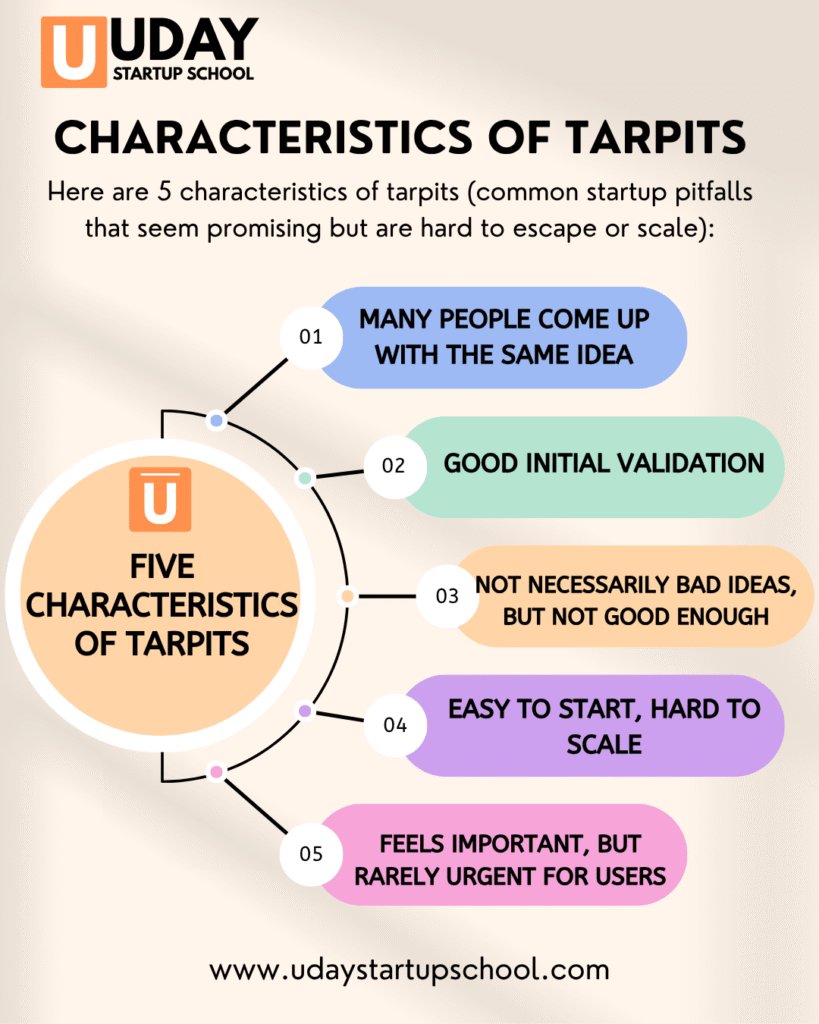What is a Tarpit? Characteristics, Examples & Insights | Uday Startup School
What is a Tarpit ?
A tarpit refers to startup ideas that seem appealing but are often overly common and challenging to execute. These ideas may attract entrepreneurs because they appear to be the “next big thing,” but they often lack innovation and are difficult to differentiate.

Characteristics of Tarpit
Here are 5 characteristics of tarpits (common startup pitfalls that seem promising but are hard to escape or scale):
- Many People Have the Same Idea
– The space is crowded with similar solutions, leading to intense competition and lack of differentiation. - Good Initial Validation but Poor Long-Term Retention
– Early feedback appears promising, but users don’t stick around or pay over time. - Not Bad Ideas, Just Not Remarkable
– These ideas solve a problem, but not in a way that’s significantly better, faster, or cheaper than existing options. - Hard to Monetize or Scale
– The problem is real, but the market size is too small or the business model doesn’t scale efficiently. - Easy to Build, Hard to Win
– Low technical barrier means anyone can enter, making it hard to establish defensibility or unique value.

Examples of Tarpits
Here are 4 examples of tarpits:
- Niche social media platforms
– e.g., social networks for founders or students, where LinkedIn or Instagram already dominate. - Friend coordination apps
– e.g., apps to plan hangouts or trips, but people default to WhatsApp, Instagram, or group chats. - Habit trackers or to-do list apps
– Thousands exist; hard to differentiate or retain users beyond the novelty. - Event discovery platforms
– e.g., local event apps trying to replace Facebook Events or Google, but fail to build network effects.
Key Insights
Consumer-focused startup ideas tend to fall into tarpits more often than B2B ideas — they have a higher “tarpit ratio.”
What is Tarpit Ratio?
Tarpit Ratio refers to the likelihood that a startup idea:
- Looks promising at first,
- Gets early user interest,
- But struggles to grow, monetize, or retain users in the long run.
A high tarpit ratio means an idea attracts many builders but few successful outcomes.
Why consumer startups have a higher tarpit ratio:
- Lower barriers to entry → Easy to build = more competition
- Harder to monetize → Users expect free apps
- Retention is tough → Casual users churn quickly
- Winner-takes-all dynamics → Big players dominate (e.g., Meta, Google)
In contrast, B2B ideas often solve more painful problems, have clearer monetization, and face less crowded markets — so their tarpit ratio is lower.
Want more insights like this on startup pitfalls, idea validation, and real-world founder lessons?
👉 Follow Uday Startup School for practical, no-fluff startup education.
💬 Join our community of aspiring founders and innovators — learn, share, and grow together!